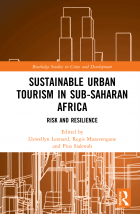Sustainable Urban Tourism in Sub-Saharan Africa

Apart from slum tourism, urban tourism in sub-Saharan Africa is under-discussed. This book attempts to fill the gap, with a focus on risk and sustainability. There are a number of challenges to developing tourism within African cities, from inadequate infrastructure to the potential for worsening eviction and exclusion of the poor. These challenges are magnified by climate change, whose effects are visible for instance in the erosion of heritage sites and the proliferation of air pollution (intensified by the transport of long-haul tourists).
Each chapter briefly illuminates a specific case, whether a major sports event (e.g. the 2010 World Cup in South Africa); an infrastructural issue (e.g. waste management in the hospitality industry in Livingstone, Zambia); a climate change issue (e.g. how flooding affects tourism in Accra); or a conflict issue (e.g. responsible tourism as a vehicle for peacebuilding in Goma). Of course, these themes are often interconnected.
The chapter on Harare explores election-linked violence and the possibility of promoting peace through tourism (or tourism through peace, as in Hiroshima). This explains, “Peace tourism involves visiting places associated with nonviolence, peaceful conflict resolution, peacemaking, prevention of war, resistance to war, protesting war and reconciliation”.
Author Regis Musavengane conducts a media analysis and proposes several options for peace-related tourism. One is a new peace museum in Harare; another is a walking route of sites connected with the liberation struggle. However, there are some paradoxical elements here, as the peace museum would be modelled on a military museum, and the walking path is at one point called a coup route. Rather than being straightforward celebrations of peace, it appears that these sites would be reminders of the complex interplay of conflict and governance in post-independence Zimbabwe.
The chapter on Windhoek has a different focus, examining whether urban tourism can help reduce poverty and inequality for current generations without harming the prospects of future generations. Author Erisher Woyo reviews documents pertaining to tourism and the Namibian economy. These reveal problems including a lack of a pro-poor tourism policy, insufficient job creation, non-local ownership of tourism businesses, and gender-based violence.
Based on this, Woyo suggests the implementation of an urban tourism development strategy that would channel revenue from tourism offerings like township tours into infrastructural improvements, education, and the promotion of gender equality. Conservation would be a critical part of this strategy, although it is not specified how.
Overall, the book’s examples show the benefits of diversifying and expanding African urban tourism – without losing sight of who exactly will benefit.
Further reading:
Hoogendoorn, Gijsbert, Nthabiseng Letsatsi, Thabisile Malleka and Irma Booyens (2020), “Tourist and resident perspectives on ‘slum tourism’: the case of the Vilakazi precinct, Soweto”, GeoJournal Vol 85, pages 1133–1149, available at http://repository.hsrc.ac.za/handle/20.500.11910/14752.
Rogerson, Christian M and Gustav Visser (2014), “A decade of progress in African urban tourism scholarship”, Urban Forum Vol 25, pages 407–417, available at https://ujcontent.uj.ac.za/vital/access/manager/Repository/uj:5491?site_name=GlobalView.
Search the Book notes database
Our Book notes database contains details and summaries of all the publications included in Book notes since 1993 - with details on how to obtain/download.
Use the search form above, or visit the Book notes landing page for more options and latest content.
For a searchable database for papers in Environment and Urbanization, go to http://eau.sagepub.com/

